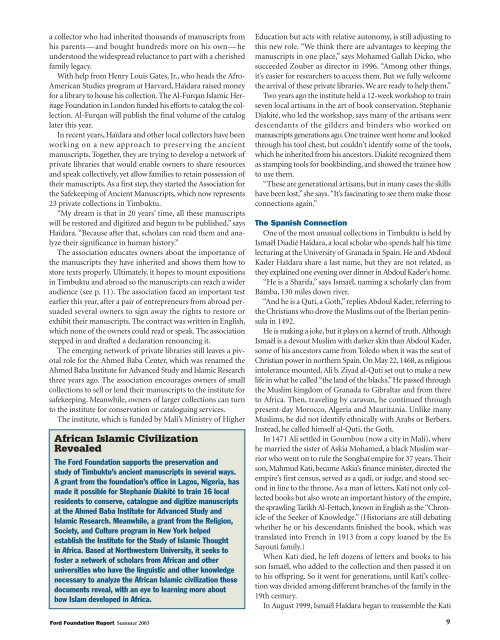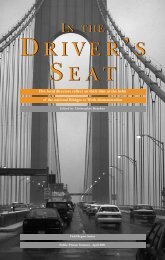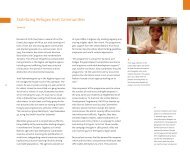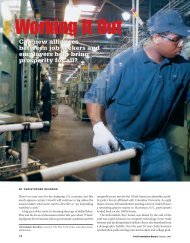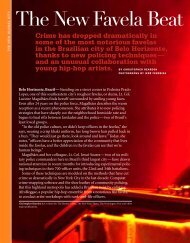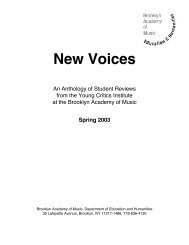Secrets of the Sahara - christopher reardon
Secrets of the Sahara - christopher reardon
Secrets of the Sahara - christopher reardon
You also want an ePaper? Increase the reach of your titles
YUMPU automatically turns print PDFs into web optimized ePapers that Google loves.
a collector who had inherited thousands <strong>of</strong> manuscripts from<br />
his parents—and bought hundreds more on his own—he<br />
understood <strong>the</strong> widespread reluctance to part with a cherished<br />
family legacy.<br />
With help from Henry Louis Gates, Jr., who heads <strong>the</strong> Afro-<br />
American Studies program at Harvard, Haïdara raised money<br />
for a library to house his collection. The Al-Furqan Islamic Heritage<br />
Foundation in London funded his efforts to catalog <strong>the</strong> collection.<br />
Al-Furqan will publish <strong>the</strong> final volume <strong>of</strong> <strong>the</strong> catalog<br />
later this year.<br />
In recent years, Haïdara and o<strong>the</strong>r local collectors have been<br />
working on a new approach to preserving <strong>the</strong> ancient<br />
manuscripts. Toge<strong>the</strong>r, <strong>the</strong>y are trying to develop a network <strong>of</strong><br />
private libraries that would enable owners to share resources<br />
and speak collectively, yet allow families to retain possession <strong>of</strong><br />
<strong>the</strong>ir manuscripts. As a first step, <strong>the</strong>y started <strong>the</strong> Association for<br />
<strong>the</strong> Safekeeping <strong>of</strong> Ancient Manuscripts, which now represents<br />
23 private collections in Timbuktu.<br />
“My dream is that in 20 years’ time, all <strong>the</strong>se manuscripts<br />
will be restored and digitized and begun to be published,” says<br />
Haïdara. “Because after that, scholars can read <strong>the</strong>m and analyze<br />
<strong>the</strong>ir significance in human history.”<br />
The association educates owners about <strong>the</strong> importance <strong>of</strong><br />
<strong>the</strong> manuscripts <strong>the</strong>y have inherited and shows <strong>the</strong>m how to<br />
store texts properly. Ultimately, it hopes to mount expositions<br />
in Timbuktu and abroad so <strong>the</strong> manuscripts can reach a wider<br />
audience (see p. 11). The association faced an important test<br />
earlier this year, after a pair <strong>of</strong> entrepreneurs from abroad persuaded<br />
several owners to sign away <strong>the</strong> rights to restore or<br />
exhibit <strong>the</strong>ir manuscripts. The contract was written in English,<br />
which none <strong>of</strong> <strong>the</strong> owners could read or speak. The association<br />
stepped in and drafted a declaration renouncing it.<br />
The emerging network <strong>of</strong> private libraries still leaves a pivotal<br />
role for <strong>the</strong> Ahmed Baba Center, which was renamed <strong>the</strong><br />
Ahmed Baba Institute for Advanced Study and Islamic Research<br />
three years ago. The association encourages owners <strong>of</strong> small<br />
collections to sell or lend <strong>the</strong>ir manuscripts to <strong>the</strong> institute for<br />
safekeeping. Meanwhile, owners <strong>of</strong> larger collections can turn<br />
to <strong>the</strong> institute for conservation or cataloguing services.<br />
The institute, which is funded by Mali’s Ministry <strong>of</strong> Higher<br />
African Islamic Civilization<br />
Revealed<br />
The Ford Foundation supports <strong>the</strong> preservation and<br />
study <strong>of</strong> Timbuktu’s ancient manuscripts in several ways.<br />
A grant from <strong>the</strong> foundation’s <strong>of</strong>fice in Lagos, Nigeria, has<br />
made it possible for Stephanie Diakité to train 16 local<br />
residents to conserve, catalogue and digitize manuscripts<br />
at <strong>the</strong> Ahmed Baba Institute for Advanced Study and<br />
Islamic Research. Meanwhile, a grant from <strong>the</strong> Religion,<br />
Society, and Culture program in New York helped<br />
establish <strong>the</strong> Institute for <strong>the</strong> Study <strong>of</strong> Islamic Thought<br />
in Africa. Based at Northwestern University, it seeks to<br />
foster a network <strong>of</strong> scholars from African and o<strong>the</strong>r<br />
universities who have <strong>the</strong> linguistic and o<strong>the</strong>r knowledge<br />
necessary to analyze <strong>the</strong> African Islamic civilization <strong>the</strong>se<br />
documents reveal, with an eye to learning more about<br />
how Islam developed in Africa.<br />
Education but acts with relative autonomy, is still adjusting to<br />
this new role. “We think <strong>the</strong>re are advantages to keeping <strong>the</strong><br />
manuscripts in one place,” says Mohamed Gallah Dicko, who<br />
succeeded Zouber as director in 1996. “Among o<strong>the</strong>r things,<br />
it’s easier for researchers to access <strong>the</strong>m. But we fully welcome<br />
<strong>the</strong> arrival <strong>of</strong> <strong>the</strong>se private libraries. We are ready to help <strong>the</strong>m.”<br />
Two years ago <strong>the</strong> institute held a 12-week workshop to train<br />
seven local artisans in <strong>the</strong> art <strong>of</strong> book conservation. Stephanie<br />
Diakité, who led <strong>the</strong> workshop, says many <strong>of</strong> <strong>the</strong> artisans were<br />
descendants <strong>of</strong> <strong>the</strong> gilders and binders who worked on<br />
manuscripts generations ago. One trainee went home and looked<br />
through his tool chest, but couldn’t identify some <strong>of</strong> <strong>the</strong> tools,<br />
which he inherited from his ancestors. Diakité recognized <strong>the</strong>m<br />
as stamping tools for bookbinding, and showed <strong>the</strong> trainee how<br />
to use <strong>the</strong>m.<br />
“These are generational artisans, but in many cases <strong>the</strong> skills<br />
have been lost,”she says. “It’s fascinating to see <strong>the</strong>m make those<br />
connections again.”<br />
The Spanish Connection<br />
One <strong>of</strong> <strong>the</strong> most unusual collections in Timbuktu is held by<br />
Ismaël Diadié Haïdara, a local scholar who spends half his time<br />
lecturing at <strong>the</strong> University <strong>of</strong> Granada in Spain. He and Abdoul<br />
Kader Haïdara share a last name, but <strong>the</strong>y are not related, as<br />
<strong>the</strong>y explained one evening over dinner in Abdoul Kader’s home.<br />
“He is a Sharifa,” says Ismaël, naming a scholarly clan from<br />
Bamba, 130 miles down river.<br />
“And he is a Quti, a Goth,” replies Abdoul Kader, referring to<br />
<strong>the</strong> Christians who drove <strong>the</strong> Muslims out <strong>of</strong> <strong>the</strong> Iberian peninsula<br />
in 1492.<br />
He is making a joke, but it plays on a kernel <strong>of</strong> truth. Although<br />
Ismaël is a devout Muslim with darker skin than Abdoul Kader,<br />
some <strong>of</strong> his ancestors came from Toledo when it was <strong>the</strong> seat <strong>of</strong><br />
Christian power in nor<strong>the</strong>rn Spain. On May 22, 1468, as religious<br />
intolerance mounted, Ali b. Ziyad al-Quti set out to make a new<br />
life in what he called “<strong>the</strong> land <strong>of</strong> <strong>the</strong> blacks.”He passed through<br />
<strong>the</strong> Muslim kingdom <strong>of</strong> Granada to Gibraltar and from <strong>the</strong>re<br />
to Africa. Then, traveling by caravan, he continued through<br />
present-day Morocco, Algeria and Mauritania. Unlike many<br />
Muslims, he did not identify ethnically with Arabs or Berbers.<br />
Instead, he called himself al-Quti, <strong>the</strong> Goth.<br />
In 1471 Ali settled in Goumbou (now a city in Mali), where<br />
he married <strong>the</strong> sister <strong>of</strong> Askia Mohamed, a black Muslim warrior<br />
who went on to rule <strong>the</strong> Songhaï empire for 37 years. Their<br />
son, Mahmud Kati, became Askia’s finance minister, directed <strong>the</strong><br />
empire’s first census, served as a qadi, or judge, and stood second<br />
in line to <strong>the</strong> throne. As a man <strong>of</strong> letters, Kati not only collected<br />
books but also wrote an important history <strong>of</strong> <strong>the</strong> empire,<br />
<strong>the</strong> sprawling Tarikh Al-Fettach, known in English as <strong>the</strong> “Chronicle<br />
<strong>of</strong> <strong>the</strong> Seeker <strong>of</strong> Knowledge.” (Historians are still debating<br />
whe<strong>the</strong>r he or his descendants finished <strong>the</strong> book, which was<br />
translated into French in 1913 from a copy loaned by <strong>the</strong> Es<br />
Sayouti family.)<br />
When Kati died, he left dozens <strong>of</strong> letters and books to his<br />
son Ismaël, who added to <strong>the</strong> collection and <strong>the</strong>n passed it on<br />
to his <strong>of</strong>fspring. So it went for generations, until Kati’s collection<br />
was divided among different branches <strong>of</strong> <strong>the</strong> family in <strong>the</strong><br />
19th century.<br />
In August 1999, Ismaël Haïdara began to reassemble <strong>the</strong> Kati<br />
Ford Foundation Report Summer 2003 9


